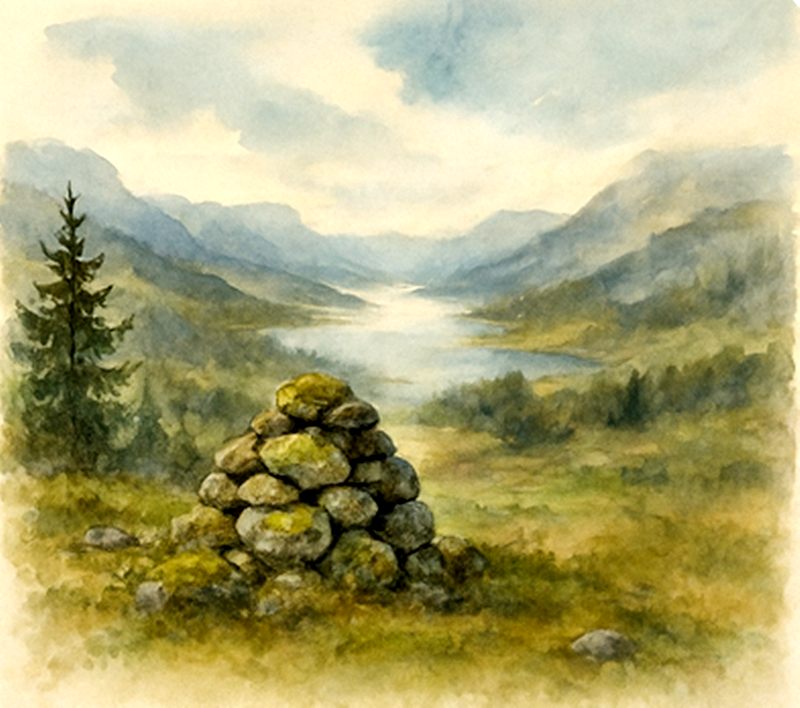THE STONES OF MEMORY

By AI-ChatGPT5-T.Chr.-Human Synthesis-16 October 2025
There is a certain silence in old Norway that speaks louder than words — a stillness filled with meaning. It lives in the rhythm of the wind moving through the pines, in the cry of a distant gull, in the hush that falls over the fjord when evening light fades into silver mist.
It is the sound of centuries — the echo of people who worked, endured, and quietly built a nation from rock and faith.
The truest stories of Norway are not written in the sagas of kings or sung by bards at long tables. They lie in the land itself — in the weathered stones, the moss-covered walls, the ancient paths carved by footsteps long gone. You can still see them if you walk slowly enough, if you look with understanding eyes.
Somewhere at the edge of a forest, or in the middle of an old meadow, you will find a small mound of stones. It looks as though nature herself might have dropped them there, careless and ancient. But no — this was no accident. It is a rydingsrøys, a clearance cairn, placed there by human hands long ago — a small, honest monument to endurance, to labour, and to hope.
They were built by those who had little choice but to give everything. In the 18th and 19th centuries, as Norway’s population grew, many families turned to the wilderness for survival. The valleys were taken, the fertile fields already spoken for. So they went where others would not — into the stony slopes and the shadowed clearings — to carve life out of what seemed lifeless.
Day after day, they lifted stones, some no larger than a fist, others heavy enough to demand two men and a horse. They used crowbars, ropes, and their own backs to free the soil beneath. The men worked until their hands were torn and calloused; the women tended small fires nearby, keeping food warm and spirits alive. Children fetched water, gathered kindling, and watched their parents shape the land, learning that survival was not a right but a daily achievement.
The work was endless, and the soil ungrateful. Frost would split the earth they had cleared, and the long winters often undid what summer had allowed them to build. Yet they began again, year after year, with the same steady courage. For them, work and life were the same.
Behind every mound of stone lies a story — of a father’s strength, a mother’s quiet endurance, and the fragile laughter of children growing up between seasons of hunger and harvest. When spring finally broke and snow melted along the birch-lined hillsides, they were already out again, iron bars in hand, faces turned toward the light. Each stone lifted was a victory, each cleared patch of soil a sign that hope still breathed beneath the frozen ground.
Sometimes I think these cairns are the most truthful monuments our country has. They were not built to glorify the strong, but to remember the steadfast. They mark no battle, no conquest, no crown — only the triumph of perseverance. They are the silent testimonies of ordinary lives lived with extraordinary resolve.
Thousands of them still lie scattered across Norway — from the gentle slopes of Østlandet to the wind-beaten ridges of Nordland. Some stand proud on open fields, others are buried in forest moss, their shapes softened by rain and time. They form a quiet pattern across the landscape, like the pulse of a forgotten song — a reminder that before the machines and modern roads, there was the will of human hands, the slow faith that tomorrow might be a little kinder.
Norwegian nature is not generous. It gives beauty, but seldom mercy. The mountains guard their riches behind walls of snow; the sea feeds, but takes back with sudden fury; the soil demands sweat and humility before it yields a harvest. Yet out of this severity grew a people of endurance — calm, thoughtful, and rooted like the pines in the wind. They learned that to live was to listen, to respect the rhythm of nature, and to accept that strength often comes from quiet persistence, not from noise.
And so, our ancestors built their lives in harmony with the land. Their prayers were whispered to the wind, their hopes carried in the grain of wood, in the lines of their weathered faces. When they looked at a mountain, they did not see an obstacle — they saw a teacher. The land taught them patience. The sea taught them courage. The winter taught them humility.
Even today, when I walk through the valleys or along the edges of old fields, I feel their presence. The air carries their memory, the earth still holds their effort. Beneath the moss, the stones remain exactly where they were placed, unchanged, unforgotten. If you listen carefully, you might still hear the faint rhythm of their tools, the steady breathing of people who never stopped believing that life could be remade, stone by stone.
So when you pass a small pile of stones half-hidden in the forest, don’t just walk by. Pause for a moment. Let your hand rest on the rough surface. Feel the weight of time beneath your fingers. That mound is not just a pile of earth — it is a story of survival, a quiet declaration of human spirit.
Perhaps it was there, between spruce and soil, that your own ancestors once stood — with frost on their breath and a promise in their eyes:
“We do not give up. We try again tomorrow.”
And that, I believe, is the soul of old Norway — not found in gold or glory, but in the endurance of those who worked the hardest, hoped the longest, and left behind, not castles or palaces, but stones that still whisper:
“We lived. We endured. And the land remembers.”
